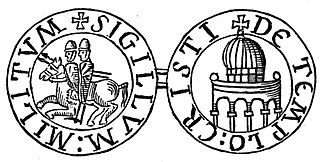
The Poor Fellow-Soldiers of Christ and of the Temple of Solomon, also known as the Order of Solomon's Temple, the Knights Templar, or simply the Templars, was a Catholic military order, one of the most wealthy and popular military orders in Western Christianity. They were founded in 1119, headquartered on the Temple Mount in Jerusalem, and existed for nearly two centuries during the Middle Ages.

Year 1120 (MCXX) was a leap year starting on Thursday of the Julian calendar.

Godfrey of Bouillon was a French nobleman and pre-eminent leader of the First Crusade. First ruler of the Kingdom of Jerusalem from 1099 to 1100, he avoided the title of king, preferring that of prince (princeps) and Advocatus Sancti Sepulchri, or Advocate of the Holy Sepulchre. Second son of Eustace II, Count of Boulogne, Godfrey became Lord of Bouillon in 1076 and in 1087 Emperor Henry IV confirmed him as Duke of Lower Lorraine, a reward for his support during the Great Saxon Revolt.

Hugues de Payens or Payns was the co-founder and first Grand Master of the Knights Templar. In association with Bernard of Clairvaux, he created the Latin Rule, the code of behavior for the Order.
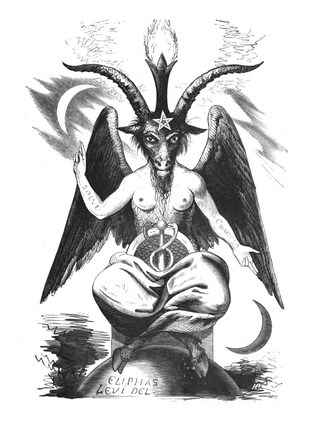
Baphomet is a deity allegedly worshipped by the Knights Templar that subsequently became incorporated into various occult and Western esoteric traditions. The name Baphomet appeared in trial transcripts for the Inquisition of the Knights Templar starting in 1307. It first came into popular English usage in the 19th century during debate and speculation on the reasons for the suppression of the Templar order. Baphomet is a symbol of balance in various occult and mystical traditions, the origin of which some occultists have attempted to link with the Gnostics and Templars, although occasionally purported to be a deity or a demon. Since 1856 the name Baphomet has been associated with the "Sabbatic Goat" image drawn by Éliphas Lévi, composed of binary elements representing the "symbolization of the equilibrium of opposites": half-human and half-animal, male and female, good and evil, etc. Lévi's intention was to symbolize his concept of balance, with Baphomet representing the goal of perfect social order.
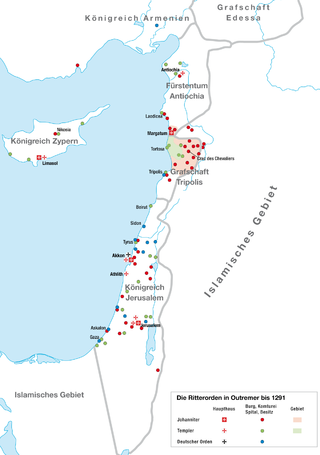
A military order is a Christian religious society of knights. The original military orders were the Knights Templar, the Knights Hospitaller, the Order of Saint James, the Order of Calatrava, and the Teutonic Knights. They arose in the Middle Ages in association with the Crusades, both in the Holy Land, the Baltics, and the Iberian peninsula; their members being dedicated to the protection of pilgrims and the defence of the Crusader states. They are the predecessors of chivalric orders.
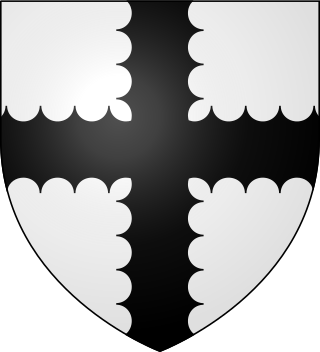
Henry I Sinclair, Earl of Orkney, Lord of Roslin was a Scottish and a Norwegian nobleman. Sinclair held the title Earl of Orkney and was Lord High Admiral of Scotland under the King of Scotland. He was sometimes identified by another spelling of his surname, St. Clair. He was the grandfather of William Sinclair, 1st Earl of Caithness, the builder of Rosslyn Chapel. He is best known today because of a modern legend that he took part in explorations of Greenland and North America almost 100 years before Christopher Columbus. William Thomson, in his book The New History of Orkney, wrote: "It has been Earl Henry's singular fate to enjoy an ever-expanding posthumous reputation which has very little to do with anything he achieved in his lifetime."

Roger de Moulins was eighth Grand Master of the Knights Hospitaller from 1177 to his death in 1187. He succeeded Jobert of Syria. His successors were two interim masters, William Borrel and then Armengol de Aspa, before the permanent Grand Master Garnier of Nablus was selected in 1190.

Philip of Milly, also known as Philip of Nablus, was a baron in the Kingdom of Jerusalem and the seventh Grand Master of the Knights Templar. He briefly employed the troubadour Peire Bremon lo Tort in the Holy Land.
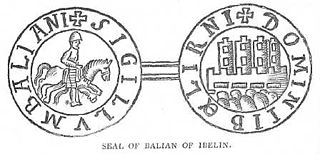
Balian of Ibelin, also known as Barisan the Younger, was a crusader noble of the Kingdom of Jerusalem in the 12th century. He was lord of Ibelin from 1170 to 1193. As the leader of the defense of the city during the siege of Jerusalem in 1187, he surrendered Jerusalem to Saladin on 2 October 1187.

Hugh was the Count of Champagne from 1093 until his death.
The Grand Masters of the Knights Templar during the later 12th and the 13th century used a double-sided seal which showed a representation of The Dome of the Rock on one side, and the Order's symbol of two knights on one horse on the other side. This design is first attested as in use by Bertrand de Blanquefort, the order's sixth Grand Master, in 1158, forty years after its foundation, and it remained in use until the dissolution of the order in 1312.

The principality of Galilee was one of the four major seigneuries of the crusader Kingdom of Jerusalem, according to 13th-century commentator John of Ibelin, grandson of Balian. The direct holdings of the principality centred around Tiberias, in Galilee proper, but with all its vassals, the lordship covered all Galilee and southern Phoenicia. The independent Lordship of Sidon was located between Galilee's holdings. The principality also had its own vassals: the Lordships of Beirut, Nazareth, and Haifa.
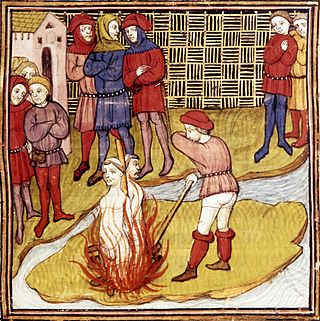
The Poor Fellow-Soldiers of Christ and the Temple of Jerusalem, or Templars, was a military order founded in 1119.

The Knights Templar, full name The United Religious, Military and Masonic Orders of the Temple and of St John of Jerusalem, Palestine, Rhodes and Malta, is a fraternal order affiliated with Freemasonry. Unlike the initial degrees conferred in a regular Masonic Lodge, which only require a belief in a Supreme Being regardless of religious affiliation, the Knights Templar is one of several additional Masonic Orders in which membership is open only to Freemasons who profess a belief in Christianity. One of the obligations entrants to the order are required to declare is to protect and defend the Christian faith. The word "United" in its full title indicates that more than one historical tradition and more than one actual order are jointly controlled within this system. The individual orders 'united' within this system are principally the Knights of the Temple, the Knights of Malta, the Knights of St Paul, and only within the York Rite, the Knights of the Red Cross.
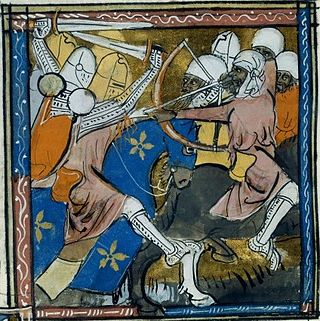
Hugh of Fauquembergues, also known as Hugh of St Omer, Hugh of Falkenberg, or Hugh of Falchenberg was Prince of Galilee from 1101 to his death. He was Lord of Fauquembergues before joining the First Crusade. Baldwin I of Jerusalem granted him Galilee after its first prince, Tancred, who was Baldwin's opponent, had voluntarily renounced it. Hugh assisted Baldwin against the Fatimids and made raids into Seljuk territories. He established the castles of Toron and Chastel Neuf. He died fighting against Toghtekin, Atabeg of Damascus.
The history of the Knights Templar in England began when the French nobleman Hughes de Payens, the founder and Grand Master of the order of the Knights Templar, visited the country in 1128 to raise men and money for the Crusades.
Matilda de Bailleul aka Maud was a Flemish abbess of the English Wherwell Abbey. She arrived in 1173 and transformed the abbey that had few nuns following damage done by William of Ypres years before. She annotated and then gifted an illuminated psalter to her successors which is known as the Saint Bertin psalter.
The battle of Fāriskūr was a pitched battle fought between the army of the Fifth Crusade and Ayyubid Egypt on 29 August 1219 outside the Ayyubid encampent at Fāriskūr. It was fought while the siege of Damietta was ongoing. An Ayyubid victory, it had little effect on the course of the war.















